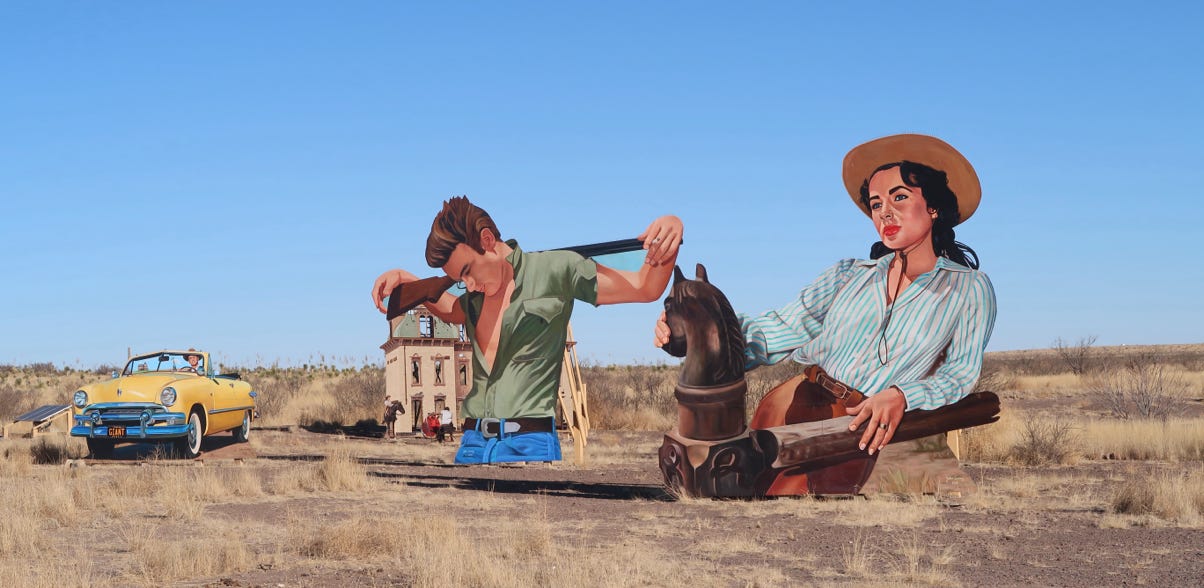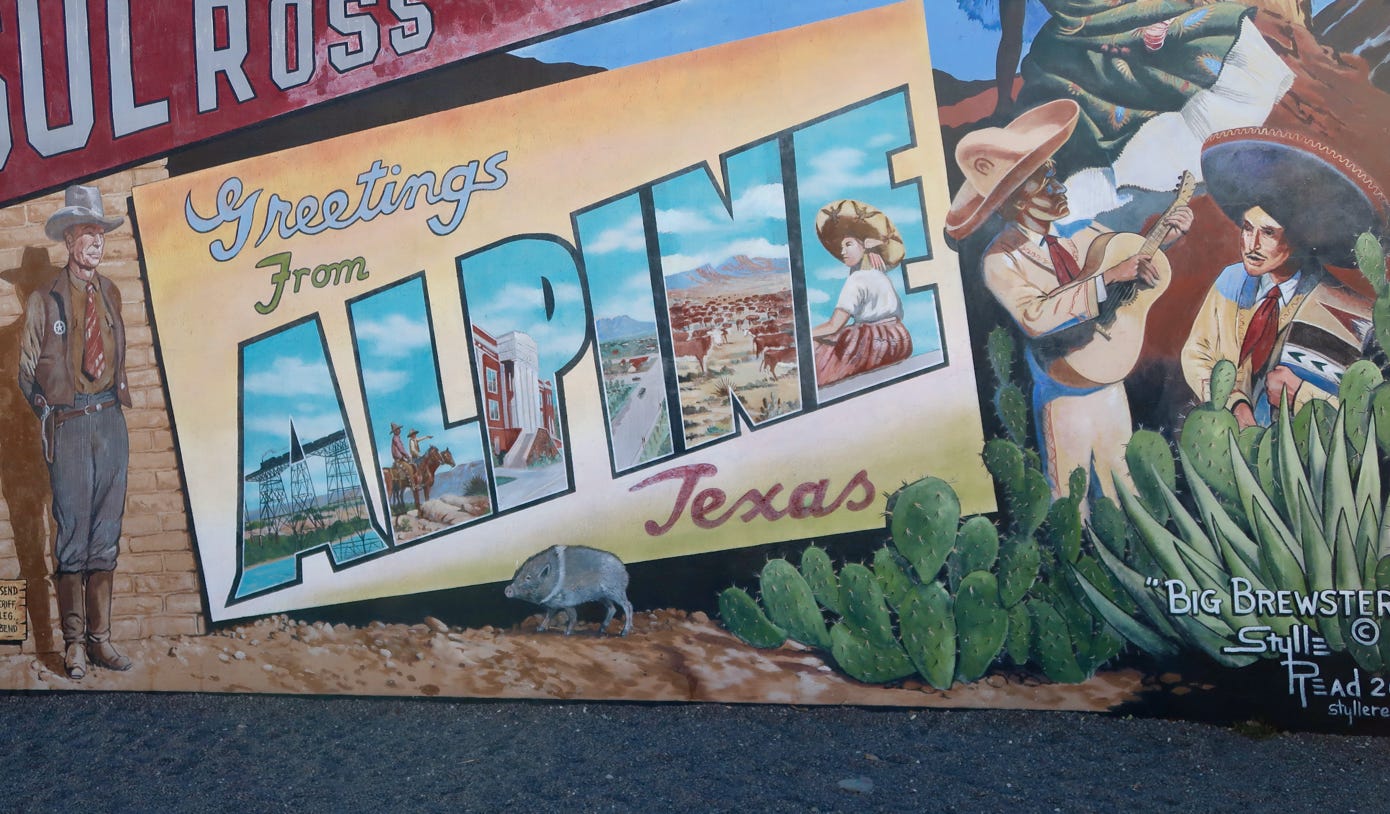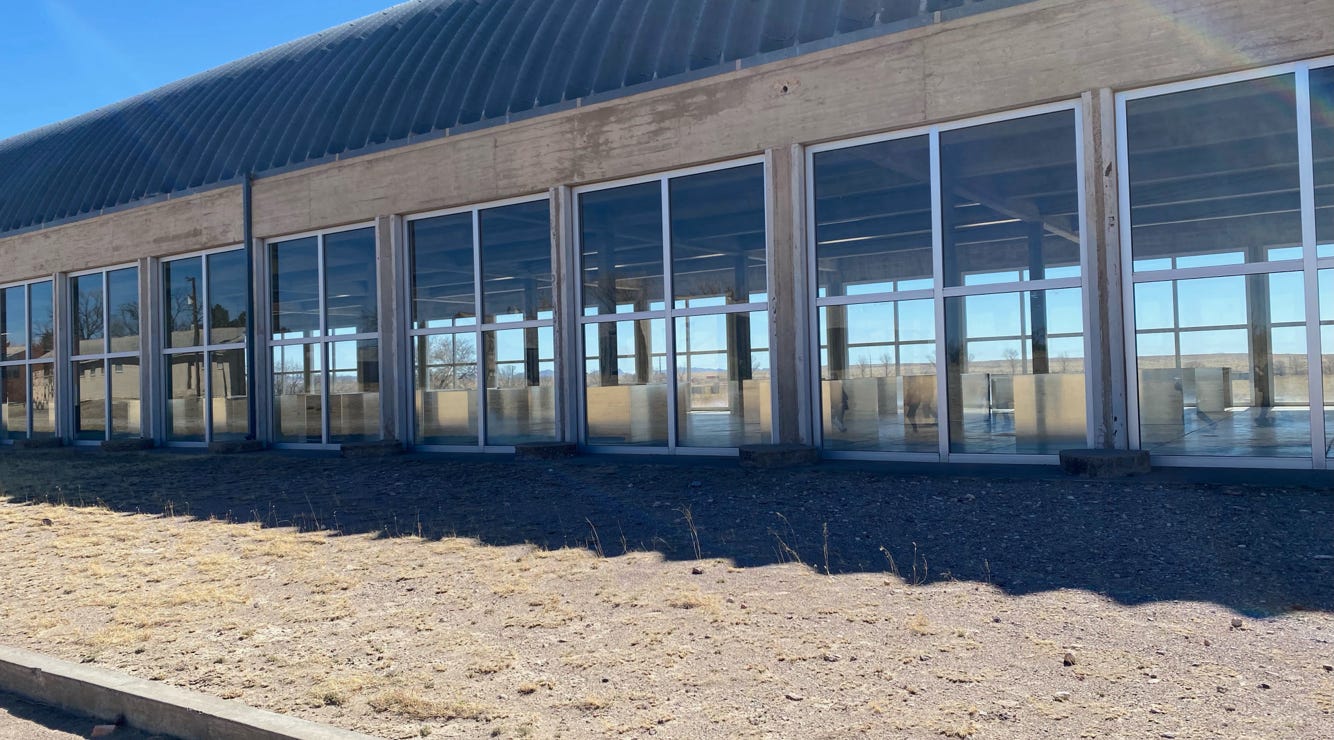Marfa, Alpine and Art


March 24, 2022
Marfa is really interesting. It has a reputation and attracts more visitors than its population of fewer than 2,000 would suggest. It was first one of the railroad stop towns (all about 30 miles apart, including neighbors Valentine and Alpine) from the late 1800’s. In the first six decades of the 20th Century, it was the location of an army base as well as a center for ranching and, briefly, oil. The movie Giant, with James Dean, was filmed here.

This installation west of town features
country music playing!

But everything changed when New York-based artist, Donald Judd, some say the founder of the minimalist movement, moved here in 1971. The town is now dominated by buildings purchased and re-purposed by Judd, as well as the two art foundations we will visit during our three-night stay. About two years into the COVID pandemic, Marfa was just beginning to re-open various tourism facilities. Tours had ceased for much of 2020, and many businesses closed.
To the left, one of the many nice galleries in town.
It was still very cold in the morning, below 30F when we got up. We therefore dialed back our plans for hiking.
After taking early morning photographs of several old Marfa buildings, we drove about a half hour east on US 90 to Alpine, Texas, which is about three times bigger than Marfa. We did a walking tour of downtown looking at about two dozen murals of various ages and styles. The downtown area was really pleasant, albeit still pretty cold. The murals have been painted at various times since the 1930’s.



We then went to the Museum of the Big Bend, located at Sul Ross University. It has excellent exhibits of the history of the area from ancient times to the twentieth century. Sul Ross University also boasts the art installation “the desk” to which we had originally intended to hike (up the hill behind the museum), but we changed our minds due to the cool temperatures.
We drove back to Marfa and had a nice lunch at the Marfa institution, The Sentinel. After lunch, we took a walking, guided tour of Donald Judd’s studio offered by the Judd Foundation. The tour took in several unattached buildings Judd had owned (he died in 1994). They included both his own completed and incomplete works, including painting, metal works and furniture, as well as items he collected from other artists. We were unfamiliar with his paintings, and although he himself was critical of them before he turned to three dimensional works, we rather liked them. One building houses models and working drawings from various projects including specs for the aluminum boxes we would see tomorrow. We enjoyed the tour and were sorry we did not have time to take the second tour the foundation offered of Judd’s home.

The old bank building on the left was Judd’s office space and was part of our tour. It contained works of art he collected.

This old grocery store was repurposed into an art studio, and inside are many of Judd’s papers, models, and completed works. It was fascinating.

Wood boxes by Donald Judd
After the tour was over, we browsed in the art galleries and boutiques in downtown Marfa. We were enjoying our visit so far.
March 25, 2022
It was finally beginning to feel like spring in the high desert, with a predicted high today around 80F. Yippee. But it was still cool in the morning.
We spent most of the day at the Chinati Foundation, looking over its big art collection. The tour we took was The Full Collection Tour which viewed everything except the Chamberlain pieces (since their gallery was closed for restoration). The most impressive works were by Mr. Judd, especially the one hundred aluminum boxes, of which no two were alike. The campus of the museum is the former army base, and the aluminum boxes are in two former artillery sheds. Other galleries were in barracks buildings. Works by other artists were varied from so-so to good, but none as great as Judd’s. Although less “minimalist” than others, we probably liked the sculpture by Claes Oldenburg and Coosje van Bruggen Monument to the Last Horse best of the works by other artists. Note, Judd was able to convince most of the other artists to donate their works to the museum, and the foundation continues to obtain new works, trying to keep to the vision of Donald Judd.
We were not allowed to bring a camera on the tour, although they did allow photos outside, so we could use our phones for that. The tour lasted from 9:30 a.m. to a little after noon, and we took a break for lunch. We ate in town at a Thai food truck.

The artillery sheds containing the aluminum boxes.

Here you can see the boxes inside.

View from our lunch spot.
After lunch, we returned to see a few more interesting things, including the abandoned Soviet–era Schoolhouse Number 6. The tour ended with Robert Irwin’s Dawn to Dusk. It is located on the site of the former army hospital. This part of the tour took under two hours. By the time is was done, it was pretty warm, so we made only a very brief stop at Judd’s 15 concrete boxes. This work can be viewed from the road leading south from Marfa.
We admit that unlike others on the tours, we were not huge devotees of Judd and the minimalist style, but we really enjoyed exposure to the works, his ethos and the dedicated artists and curators keeping his properties going close to 20 years after his death. For us, the juxtaposition of the art with the small west Texas town and the desert location were quite fascinating.

Irwin’s Dawn to Dusk
After the tour was over, we drove around Marfa to find some more noted buildings, and then went to the (small) Presidio County Museum.
Since it was warm, we ate dinner at our last evening outside at a millennial run BBQ establishment located in a former gas station (open only Friday and Saturdays). We enjoyed it quite a bit, not having been fans of BBQ before. We concluded, that as Californians, we probably had never had “good” BBQ before, we probably prefer the (West) Texas style (dry with sauce optional) than other styles we had (Memphis/Tennessee, Kansas City), or maybe a little of both.
That brought our stay in Marfa to a close, and we have to say, it may not be everyone’s cup of tea, but we greatly enjoyed it.
Tomorrow, we head to even more remote areas of the region, including the Big Bend. The map below shows many of the West Texas sites we will visit.
